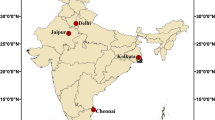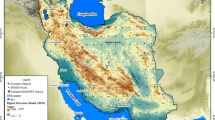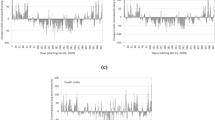Abstract
Perennial increase in atmospheric pollution over the Bay of Bengal (BoB) and South China Sea is reported due to increase in human population and industrial activity in South and Southeast Asia. Based on total aerosol optical depth (AOD) derived from MODIS (moderate resolution imaging resolution imaging spectroradiometer), natural and anthropogenic fractions were derived. The seasonality and spatial variability in rate of increase in total, natural, and anthropogenic AOD fractions were examined over the BoB using data collected between 2001 and 2019. Both total and anthropogenic AOD displayed statistically significant rate of increase in the northwest BoB (NWB) and western coastal BoB (WCB) regions during 2001 to 2019 whereas the long-term changes are insignificant in the other regions of BoB. Significant increase in AOD in the NWB and WCB regions is mainly contributed by dominant outflow of anthropogenic emissions from Indo-Gangetic Plain (IGP) area of Indian subcontinent. The magnitude of AOD decreased by half from northern BoB to equatorial region due to increase in distance from the source region. The contribution of anthropogenic AOD was >70% to total AOD with higher contribution during winter and lower during summer. The rate of increase in both total and anthropogenic AOD was close to 0.104 and 0.099 per decade in the NWB and 0.069 and 0.059 per decade in the WCB region between 2001 and 2019. The rate of increase in total and anthropogenic AOD decreased from 2001–2009 (0.164 and 0.115 per decade respectively) to 2010–2019 (0.068 and 0.076 per decade respectively) in the NWB region. Significant increase in anthropogenic AOD by 50 and 30% was observed during El Niño and La Niña periods respectively than normal year in both northwest BoB (NWB) and western coastal (WCB) regions due to change in strength and direction of winds. Although some fraction of anthropogenic AOD is found over the entire BoB, significant rate of increase in anthropogenic AOD is found only about 23% of the area of BoB than hitherto reported as entire BoB. The impact of atmospheric deposition of anthropogenic aerosols on biogeochemical processes, such as primary production and ocean acidification, needs further evaluation.










Similar content being viewed by others
Data availability
We used remote sensing sensors data and the web links where data are available are given.
References
Babu SS, Manoj MR, Moorthy KK, Gogoi MM, Nair VS, Kompalli SK, Satheesh SK, Niranjan K, Ramagopal K, Bhuyan PK, Singh D (2013) Trends in aerosol optical depth over Indian region: potential causes and impact indicators. J Geophys Res-Atmos 118(20):11–794
Beegum SN, Moorthy KK, Nair VS, Babu SS, Satheesh SK, Vinoj V, Reddy RR, Gopal KR, Badarinath KVS, Niranjan K, Pandey SK (2008) Characteristics of spectral aerosol optical depths over India during ICARB. Journal of Earth System Science 117(1):303–313
Biswas H, Alexander CROS, Yadav K, Ramana VV, Prasad VR, Acharyya T, Babu PR (2011) The response of a natural phytoplankton community from the Godavari River Estuary to increasing CO2 concentration during the pre-monsoon period. J Exp Mar Biol Ecol 407(2):284–293
Biswas H, Gadi SD, Ramana VV, Bharathi MD, Priyan RK, Manjari DT, Kumar MD (2012) Enhanced abundance of tintinnids under elevated CO 2 level from coastal Bay of Bengal. Biodivers Conserv 21(5):1309–1326
Biswas H, Shaik AUR, Bandyopadhyay D, Chowdhury N (2017) CO2 induced growth response in a diatom dominated phytoplankton community from SW Bay of Bengal coastal water. Estuar Coast Shelf Sci 198:29–42
Che H, Gui K, Xia X, Wang Y, Holben BN, Goloub P, Cuevas-Agulló E, Wang H, Zheng Y, Zhao H, Zhang X (2019) Large contribution of meteorological factors to inter-decadal changes in regional aerosol optical depth. Atmos Chem Phys 19(16):10497–10523
Cohen JB (2014) Quantifying the occurrence and magnitude of the Southeast Asian fire climatology. Environ Res Lett 9(11):114018
Das SK, Jayaraman A (2012) Long-range transportation of anthropogenic aerosols over eastern coastal region of India: investigation of sources and impact on regional climate change. Atmos Res 118:68–83
Das S, Giorgi F, Giuliani G, Dey S, Coppola E (2020) Near-future anthropogenic aerosol emission scenarios and their direct radiative effects on the present-day characteristics of the indian summer monsoon. J Geophys Res-Atmos 125(4):e2019JD031414
de Leeuw G, Sogacheva L, Rodriguez E, Kourtidis K, Georgoulias AK, Alexandri G, Amiridis V, Proestakis E, Marinou E, Xue Y (2018) Two decades of satellite observations of AOD over mainland China using ATSR-2, AATSR and MODIS/Terra: data set evaluation and large-scale patterns. Atmos Chem Phys 18(3):1573
Dey S, Di Girolamo L (2011) A decade of change in aerosol properties over the Indian subcontinent. Geophys Res Lett 38. https://doi.org/10.1029/2011GL048153
Dey S, Singh RP (2002) Retrieval of aerosol parameters using IRS P4 OCM data over the Arabian Sea and the Bay of Bengal. Curr Sci 83:1235–1240
Dey S, Sarkar S, Singh RP (2004) Comparison of aerosol radiative forcing over the Arabian Sea and the Bay of Bengal. Adv Space Res 33(7):1104–1108
Dong L, Zhou T (2014) The Indian Ocean sea surface temperature warming simulated by CMIP5 models during the twentieth century: Competing forcing roles of GHGs and anthropogenic aerosols. J Clim 27:3348–3362
Ganguly D, Jayaraman A, Gadhavi H (2005) In situ ship cruise measurements of mass concentration and size distribution of aerosols over Bay of Bengal and their radiative impacts. J Geophys Res 110:D06205. https://doi.org/10.1029/2004JD005325
Girolamo LD, Bond TC, Bramer D, Diner DJ, Fettinger F, Kahn RA, Martonchik JV, Ramana MV, Ramanathan V, Rasch PJ (2004) Analysis of multi-angle imaging spectroradiometer (MISR) aerosol optical depths over greater India during winter 2001–2004. Geophys Res Lettrs 31. https://doi.org/10.1029/2004GL021273
Gogoi MM, Bhuyan PK, Krishna Moorthy K (2008) Estimation of the effect of long-range transport on seasonal variation of aerosols over northeastern India. Ann Geophys 26(6):1365–1377
Hsu NC, Gautam R, Sayer AM, Bettenhausen C, Li C, Jeong MJ, Tsay SC, Holben BN (2012) Global and regional trends of aerosol optical depth over land and ocean using SeaWiFS measurements from 1997 to 2010. Atmos Chem Phys 12(17):8037–8053
IPCC (Intergovernmental Panel on Climate Change)(2001) The observed changes in the climate system. In: Houghton JT, Ding Y, Griggs DJ, Noguer M, van der Linden PJ (eds) Climate Change 2001: The Scientific Basis. Cambridge University Press, New York, pp 25–30
Jethva H, Satheesh SK, Srinivasan J (2005) Seasonal variability of aerosols over the Indo-Gangetic basin. J Geophys Res-Atmos 110(D21)
Kaskaoutis DG, Kharol SK, Sinha PR, Singh RP, Badarinath KVS, Mehdi W, Sharma M (2011) Contrasting aerosol trends over South Asia during the last decade based on MODIS observations. Atmospheric Measurement Techniques Discussions 4(4):5275–5323
Kaufman YJ, Tanré D, Remer LA, Vermote EF, Chu A, Holben BN (1997) Operational remote sensing of tropospheric aerosol over land from EOS moderate resolution imaging spectroradiometer. J Geophys Res-Atmos 102(D14):17051–17067
Kaufman YJ, Smirnov A, Holben BN, Dubovik O (2001) Haseline maritime aerosol: Methodology to derive the optical thickness and scattering properties. Geophys Res Lett 28:3251–3254
Kaufman YJ, Boucher O, Tanré D, Chin M, Remer LA, Takemura T (2005a) Aerosol anthropogenic component estimated from satellite data. Geophys Res Lett 32(17)
Kaufman YJ, Koren I, Remer LA, Tanre D, Ginoux P, Fan S (2005b) Dust transport and deposition observed from the terra-moderate resolution imaging spectroradiometer (MODIS) spacecraft over the Atlantic Ocean. J Geophys Res 110:DIOS12. https://doi.org/10.1029/2003JD004436
Keshtgar B, Alizadeh-Choobari O, Irannejad P (2020) Seasonal and interannual variations of the intertropical convergence zone over the Indian Ocean based on an energetic perspective. Clim Dyn 54:3627–3639
Klingmüller K, Pozzer A, Metzger S, Stenchikov GL, Lelieveld J (2016) Aerosol optical depth trend over the Middle East. Atmos Chem Phys 16:5063–5073
Knobelspiesse KD, Pietras C, Fargion GS, Wang M, Frouin R, Miller MA, Subramaniam A, Balch WM (2004) Maritime aerosol optical thickness measured by handheld sun photometers. Remote Sens Environ 93(1-2):87–106
Kumar A, Sudheer AK, Sarin MM (2008) Chemical characteristics of aerosols in MABL of Bay of Bengal and Arabian Sea during spring inter-monsoon: a comparative study. Journal of earth system science 117(1):325–332
Levy RC, Mattoo S, Munchak LA, Remer LA, Sayer AM, Patadia F, Hsu NC (2013) The collection 6 MODIS aerosol products over land and ocean. Atmos Meas Tech 6:2989–3034
Li J, Carlson BE, Lacis AA (2011) El Niño-Southern Oscillation correlated aerosol Ångström Exponent anomaly over the tropical Pacific discovered in satellite measurements. J Geophys Res 116:D20204. https://doi.org/10.1029/2011JD015733
Mehta M (2015) A study of aerosol optical depth variations over the Indian region using thirteen years (2001–2013) of MODIS and MISR Level 3 data. Atmos Environ 109:161–170
Moorthy KK, Babu SS (2006) Aerosol black carbon over Bay of Bengal observed from an island location, Port Blair: temporal features and long-range transport. J Geophys Res-Atmos 111(D17)
Moorthy KK, Suresh Babu S, Satheesh SK (2003) Aerosol spectral optical depths over the Bay of Bengal: role of transport. Geophys Res Lett 30:1249. https://doi.org/10.1029/2002GL016520
Moorthy KK, Babu SS, Satheesh SK (2005) Aerosol characteristics and radiative impacts over the Arabian Sea during the intermonsoon season: results from ARMEX field campaign. J Atmos Sci 62:192–206. https://doi.org/10.1175/JAS-3378.1
Murtugudde R, McCreary JP Jr, Busalacchi AJ (2000) Oceanic processes associated with anomalous events in the Indian Ocean with relevance to 1997–1998. J Geophys Res Oceans 105(C2):3295–3306
Nair VS, Moorthy KK, Alappattu DP, Kunhikrishnan PK, George S, Nair PR, Babu SS, Abish B, Satheesh SK, Tripathi SN, Niranjan K (2007) Wintertime aerosol characteristics over the Indo-Gangetic Plain (IGP): impacts of local boundary layer processes and long-range transport. J Geophys Res-Atmos 112(D13)
Nair VS, Babu SS, Moorthy KK (2008) Aerosol characteristics in the marine atmospheric boundary layer over the Bay of Bengal and Arabian Sea during ICARB: spatial distribution and latitudinal and longitudinal gradients. J Geophys Res-Atmos 113(D15)
Nair VS, Moorthy KK, Babu SS, Satheesh SK (2009) Optical and physical properties of atmospheric aerosols over the Bay of Bengal during ICARB. J Atmos Sci 66(9):2640–2658
Nair VS, Satheesh SK, Moorthy KK, Suresh Babu S, Nair PR, George SK (2010) Suprising observation of large anthropogenic aerosol fraction over the “near-pristine” southern Bay of Bengal: climate implications. J Geophys Res-Atmos:115. https://doi.org/10.1029/2010JD013954
Nair VS, Moorthy KK, Babu SS (2013) Influence of continental outflow and ocean biogeochemistry on the distribution of fine and ultrafine particles in the marine atmospheric boundary layer over Arabian Sea and Bay of Bengal. J Geophys Res-Atmos 118(13):7321–7331
Nair PR, George SK, Aryasree S, Jacob S (2014) Chemical composition of aerosols over Bay of Bengal during pre-monsoon: Dominance of anthropogenic sources. Journal of Atmospheric Solar-Terrestrial Physics 109:54–65
Niranjan K, Sreekanth V, Madhavan BL, Krishna Moorthy K (2007) Aerosol physical properties and Radiative forcing at the outflow region from the Indo-Gangetic plains during typical clear and hazy periods of wintertime. Geophys Res Lett 34(19)
Pozzer A, De M, Yoon J A, Tost H, Georgoulias AK, Astitha M (2015) AOD trends during 2001–2010 from observations and model simulations. Atmos Chem Phys 15(10):5521–5535
Prasad AK, Singh RP, Singh A (2006) Seasonal climatology of aerosol optical depth over the Indian subcontinent: trend and departures in recent years. Int J Remote Sens 27(12):2323–2329
Prijith SS, Rajeev K, Thampi BV, Nair SK, Mohan M (2013) Multi-year observations of the spatial and vertical distribution of aerosols and the genesis of abnormal variations in aerosol loading over the Arabian Sea during Asian summer monsoon season. J Atmos Sol Terr Phys 105:142–151
Proestakis E, Amiridis V, Marinou E, Georgoulias AK, Solomos S, Kazadzis S, Chimot J, Che H, Alexandri G, Binietoglou I, Daskalopoulou V (2018) Nine-year spatial and temporal evolution of desert dust aerosols over South and East Asia as revealed by CALIOP. Atmos Chem Phys 18:1337–1362
Prospero JM, Ginoux P, Torres O, Nicholson SE, Gill TE (2002) Environmental characterization of global sources of atmospheric soil dust identified with the Nimbus 7 total ozone mapping spectrometer (TOMS) absorbing aerosol product. Rev Geophys 40(1):2–1
Ramachandran S (2005) Aerosol radiative forcing over Bay of Bengal and Chennai: comparison with maritime, continental, and urban aerosol models. J Geophys Res-Atmos 110(D21)
Ramana MV, Ramanathan V, Podgorny IA, Pradhan BB, Shrestha B (2004) The direct observations of large aerosol radiative forcing in the Himalayan region. Geophys Res Lett 31(5)
Ramanathan V, Crutzen PJ, Lelieveld J, Mitra AP, Althausen D, Anderson J, Andreae MO, Cantrell W, Cass GR, Chung CE, Clarke AD (2001) Indian Ocean experiment: an integrated analysis of the climate forcing and effects of the great Indo-Asian haze. J Geophys Res-Atmos 106(D22):28371–28398
Ramanathan V, Li F, Ramana MV, Praveen PS, Kim D, Corrigan CE, Nguyen H, Stone EA, Schauer JJ, Carmichael GR, Adhikary B, Yoon SC (2007) Atmospheric brown clounds: hemispherical and regional variations in long-range transport, absorption and radiative forcing. J Geophys Res-Atmos 112:D22. https://doi.org/10.1029/2006JD008124
Reid JS, Hyer EJ, Johnson RS, Holben BN, Yokelson RJ, Zhang J, Campbell JR, Christopher SA, Di Girolamo L, Giglio L, Holz RE (2013) Observing and understanding the Southeast Asian aerosol system by remote sensing: an initial review and analysis for the Seven Southeast Asian StudieUHs (7SEAS) program. Atmos Res 122:403–468
Sarma VVSS (2006) The influence of Indian ocean dipole (IOD) on biogeochemistry of carbon in the Arabian Sea during 1997–1998. J Earth Syst Sci 115:433–450
Sarma VVSS, Paul YS, Vani DG, Murty VSN (2015) Impact of river discharge on the coastal water pH and pCO2 levels during the Indian Ocean Dipole (IOD) years in the western Bay of Bengal. Cont Shelf Res 107:132–140
Satheesh SK, Vinoj V, Moorthy KK (2006) Vertical distribution of aerosols over an urban continental site in India inferred using a micro pulse lidar. Geophys Res Lett 33(20)
Satheesh SK, Vinoj V, Moorthy KK (2010) Assessment of aerosol radiative impact over oceanic regions adjacent to Indian subcontinent using multisatellite analysis. Atmospheric Aerosols and Climate 139186:1–13. https://doi.org/10.1155/2010/139186
Schott F, McCreary JP (2001) The monsoon circulation of the Indian Ocean. Prog Oceanogr 51:1–123
Singh RP, Dey S, Tripathi SN, Tare V, Holben BN (2004) Variability of aerosol parameters over Kanpur city in northern India. J Geophys Res 109:D23206. https://doi.org/10.1029/2004JD004966
Sinha PR, Manchanda RK, Kaskaoutis DG, Sreenivasan S, Krishna Moorthy K, Suresh Babu S (2011) Spatial heterogeneities in aerosol size distribution over the Bay of Bengal during Winter-ICARB Experiment. Atmos Environ 45:4695–4706
Soman MK, Kumar KK (1990) Some aspects of daily rainfall distribution over India during the southwest monsoon season. International Journal of Climate 19:299–311
Spandana B, Niranjan K, Devi TA (2012) Advection induced short period anomalies and seasonal features in aerosol optical depth over Bay of Bengal in the W-ICARB region. Atmos Environ 51:175–186
Sreekanth V, Kulkarni P (2013) Spatio-temporal variations in columnar aerosol optical properties over Bay of Bengal: Signatures of elevated dust. Atmos Environ 69:249–257
Streets DG, Bond TC, Carmichael GR, Fernandes SD, Fu Q, He D, Klimont Z, Nelson SM, Tsai NY, Wang MQ, Woo JH (2003) An inventory of gaseous and primary aerosol emissions in Asia in the year 2000. J Geophys Res-Atmos 108(D21)
Sumanth E, Mallikarjuna K, Stephen J, Moole M, Vinoj V, Satheesh SK, Moorthy KK (2004) Measurements of aerosol optical depths and black carbon over Bay of Bengal during post-monsoon season. Geophys Res Lett 31(16)
Taylor D (2010) Biomass burning, humans and climate change in Southeast Asia. Biodivers Conserv 19(4):1025–1042
Tiwari S, Mishra AK, Singh AK (2015) Aerosol climatology over the Bay of Bengal and Arabian Sea inferred from Space-borne Radiometers and Lidar Observations. Aerosol Air Qual Res 16(11):2855–2868
Vinoj V, Suresh Babu S, Satheesh SK, Moorthy K, Kaufman YJ (2004) Radiative forcing by aerosols over the Bay of Bengal region derived from shipborne, island-based, and satellite (moderate-resolution imaging spectroradiometer) observations. J Geophys Res 109:D05203. https://doi.org/10.1029/2003JD004329
Vinoj V, Satheesh SK, Moorthy KK (2009) Optical, radiative,and source characteristics of aerosols at Minicoy, a remote island inthe southern Arabian Sea. J Geophys Res 114:D01201. https://doi.org/10.1029/2009JD011810
Wei J, Peng Y, Mahmood R, Sun L, Guo J (2019) Intercomparison in spatial distributions and temporal trends derived from multi source satellite aerosol products. Atmos Chem Phys 19:7183–7207
Yadav K, Sarma VVSS, Rao DB, Kumar MD (2016) Influence of atmospheric dry deposition of inorganic nutrients on phytoplankton biomass in the coastal Bay of Bengal. Mar Chem 187:25–34
Zhang J, Reid JS (2010) A decadal regional and global trend analysis of the aerosol optical depth using a data assimilation grade over-water MODIS and level 2 MISR aerosol products. Atmos Chem Phys 10:10949–10963
Zhao TXP, Laszlo I, Guo W, Heidinger A, Cao C, Jelenak A, Tarpley D, Sullivan J (2008) Study of long-term trend in aerosol optical thickness observed from operational AVHRR satellite instrument. J Geophys Res-Atmos 113(D7)
Acknowledgements
We would like to thank NASA Earth Science division for making available MODIS on their website to conduct this study. We would like to thank two anonymous reviewer for their critical review and suggestion on our manuscript. We would like to thank Director, CSIR-NIO and Scientist-In-Charge, Regional Centre, Visakhapatnam, for their encouragement and support. This has NIO contribution number of 6749.
Author information
Authors and Affiliations
Contributions
KY—processing of total AOD data, preparation of figures, and initial manuscript preparation
VDR—computation of natural, and anthropogenic contribution of AOD, preparation of figures, and discussion during manuscript preparation
SB—processing of AOD data, preparing trends, and involved in manuscript preparation
VVSS—concept of the work, and guidance and finalizing the manuscript.
Corresponding author
Ethics declarations
Ethics approval and consent to participate
Not applicable.
Consent for publication
Not applicable.
Competing interests
The authors declare no competing interests.
Additional information
Responsible editor: Philippe Garrigues
Publisher’s note
Springer Nature remains neutral with regard to jurisdictional claims in published maps and institutional affiliations.
Rights and permissions
About this article
Cite this article
Yadav, K., Rao, V., Sridevi, B. et al. Decadal variations in natural and anthropogenic aerosol optical depth over the Bay of Bengal: the influence of pollutants from Indo-GangeticPlain. Environ Sci Pollut Res 28, 55202–55219 (2021). https://doi.org/10.1007/s11356-021-14703-x
Received:
Accepted:
Published:
Issue Date:
DOI: https://doi.org/10.1007/s11356-021-14703-x




